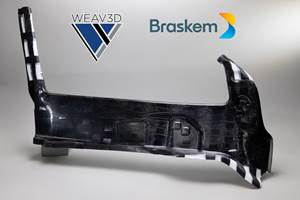Highlights from JEC Americas
Biomimetics, biomaterials and more.
Street Shark hood developed by FRIMO and 3D|Core. SOURCE: CompositesWorld
JEC Americas 2014 (May 13-15, Atlanta, Ga., USA) bestowed Innovation Awards on 10 composites companies and recognized others in the Innovation Showcase. Here are my highlights.
Category: Automotive
Award Winner: FRIMO (Lotte, Germany and Wixom, Mich., USA)
“Street Shark” engine hood
The “Street Shark” is a BMW Z4 with and engine hood and roof module made from a sandwich composite with a shark skin textured surface. The composite uses Vitrox resin from Huntsman Polyurethanes (Auburn Hills, Mich. and Everberg, Belgium), a “tunable” snap-cure system (see CT Feb 2011 and CT April 2014 articles) and core from partner Expanded Structured Composites GmbH & Co. KG (a.k.a. ESC GmbH, 3D|CORE or 3D-Core, Herford, Germany), a manufacturer of structural foam core products based on polyethylene terephthalate (PET), polyurethanisocyanurate (PUR), polyisocyanurate (PIR) and extruded polystyrene (XPS). 3D|CORE claims that its new C+ product line — a thin core with flow channels for faster resin injection and reduced fiber washing — can reduce carbon fiber and resin material input by up to 50 percent while improving acoustic, thermal and electrical insulation values as well as vibration behavior.
FRIMO and 3D|CORE formed the joint project L.E.S.L.I.E., which stands for “Low Energy, Speed and Less Input of Material and Equipment” in 2013. Frimo’s contribution is as a tooling and resin transfer molding (RTM) technology specialist, offering a full range of tooling and equipment for polyurethane (PU) processing.
For the shark skin, a surface geometry formed from the impression of a genuine shark was applied to the mold by Eschmann-Textures (Gummersbach, Germany) to reduce aerodynamic drag. Wind tunnel testing showed promising results. Further studies are planned including the textured surface’s impact on soiling susceptibility and wear resistance.
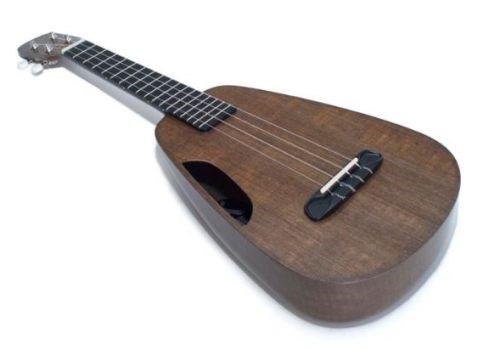
Clara ukulele made from Ekoa compsites. SOURCE: Blackbird Guitars
Category: Sports and Leisure
Award Winner: BComp (Fribourg, Switzerland)
First ukulele made from natural fiber Ekoa composites
Clara is the first concert-level instrument to be made from natural fiber composites. To develop this product, Lingrove Composites (San Franciscio, Calif., USA) combined BComp’s low-crimp ampliTex flax fabrics with a bio-resin based on cashew nut shell liquid (CNSL) to make a novel, high-performance prepreg named Ekoa. The material combines low weight, high strength and toughness with an unparalleled sound quality. (Lingrove has also developed Ekoa prepregs with resins made with biofuel production waste sourced from Entropy Resins in Hayward, Calif., USA.) Building on its success in developing carbon fiber acoustic guitars and ukuleles since 2005, sister company, Blackbird Guitars (San Francisco, Calif., USA) dedicated several years of research and development into engineering Ekoa materials into an advanced composite construction and design for this game-changing instrument.
The concert-quality Clara ukulele is revolutionary because it offers the tone of vintage wood and the durability of cutting-edge, eco-friendly construction. Ekoa presents a potentially very important material solution for the musical instrument industry because good quality “tone” comes from old growth wood, which is increasingly difficult to source and its quality is ever deteriorating. Since its launch in November 2013, dozens of Clara ukuleles have been sold, and Blackbird aims at growing this number to several hundred units per year by 2015.
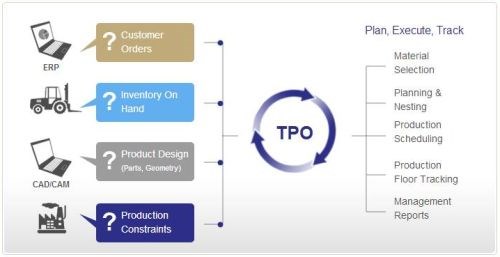
Plataine Total Production Optimization solution for composites manufacturing.
SOURCE: Plataine
Category: Software
Award Winner: Plataine (Tel Aviv, Israel and Waltham, Mass.)
Integrated Production Optimization – New technology bridges the gap between CAD and ERP
Software solutions traditionally used in production environments — including software for enterprise resource planning (ERP), computer-aided design (CAD) and inventory management — are loosely integrated, if at all. ERP often deals with order information alone (not considering geometric information) while computer aided manufacturing (CAM) software is typically applied at the product library level vs. the order level. This results in inflexible production where changes are costly, lead times are long and resources are wasted (e.g., materials and labor), as well as excess inventory of materials and added risk to quality and customer satisfaction. Decision-making processes are serial, resulting in limits imposed by prior steps, and made by poorly integrated software and teams.
Plataine developed the Total Production Optimization (TPO) solution to provide real-time optimization of all production process factors including customer orders, materials available from inventory and product design from the CAD system. TPO optimizes, dynamically and automatically, on a case-by-case basis, which orders to produce, which pieces to cut, which rolls to use, which machines to use and when. The TPO solution already supports manufacturers who produce composite components for aerospace, wind energy, personal armor, industrial fabrics and consumer goods in Europe, Asia and the USA.
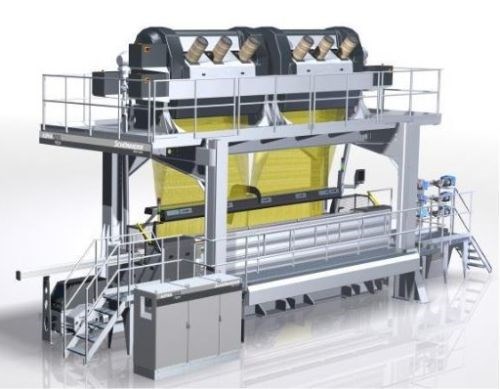
ALPHA 500 TECH loom produces integrated semi-finished fabrics for composites.
SOURCE: Stäubli
Category: Reinforcements
Award Winner: Stäubli (Pfäffikon, Switzerland and Duncan, S.C., USA)
Double rapier weaving for economical 3-D weaving
Stäubli has developed the innovative ALPHA 500 TECH loom to produce locally adapted multilayer weaves. In contrast to conventional weaving machines, two or more grippers arranged on top of each other can be used for the weft insertion, which enhances productivity. This development enables new design freedom coupled with high productivity and a one-step process, resulting in the economic production of locally modified flat, multilayer and spacer fabrics, as well as combinations of these. The fibers can be deposited with non-crimp properties such as high tensile and compression strength. Thus, more affordable highly integrated semi-finished fabrics that combine high properties with through-thickness delamination resistance and fail-safe behavior are possible.
Category: Raw Materials
Award Winner: TSE Industries (Clearwater, Fla., USA)
VOC- and BPA-free bio-based polyurethane resin for sprayup
TSE-EcoSpray 550, made from renewable natural oils, does not contain any volatile organic compounds (VOCs) or Bisphenol A (BPA), and is also touted to be free from solvents and styrene odor. Designed as a drop-in solution to styrene polyester for use in baths, hot tub spas and much more, EcoSpray 550 also reportedly cures in 25 minutes vs. hours for traditional resins. The company also won an Innovation Award last year for its TSE-EcoWind thermoset resin system for composites made with filament winding.
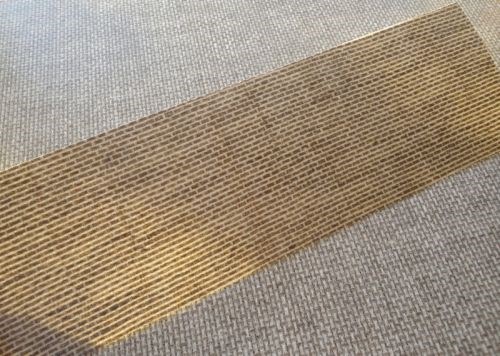
TWINFLAX prepreg made from flax reinforced Rilsan PA 11 polyamide resin.
SOURCE: Flax Technic DEHONDT Group
Flax Technic (Notre Dame de Gravenchon, France) was recognized in the Aeronautics category for: Zodiac cabin interiors Europe initiating a paradigm shift in the construction of cabin interiors. Flax Technic (business through which flax producer DEHONDT Group has diversified into composites) is one of the 17 members of the FIMALIN flax industry association in France which has launched the FIBALIN project to develop prototypes using flax fibers for automotive, aerospace, marine and building/construction applications.
As part of this 5-year, € 18 million program, Flax Technic has pursued development work with Zodiac Aerospace (Plaisir, France) to replace glass fiber and phenolic resin with a flax fiber reinforced polyamide resin in the form of TWINFLAX prepreg. The Rilsan PA11 polyamide resin is supplied by Arkema (Colombes, France) and is reportedly the only high-performance polyamide 11 to be made from a natural raw material, the castor plant.
According to a report published by ecocomposites.net, Zodiac is planning to use the TWINFLAX prepreg in a seat shelf for its premium and business class seats. Benefits include a 26 percent weight savings which reduces aircraft fuel consumption and a reduction in the ecological footprint of aircraft interiors production via the material’s recyclability and renewable sources. FlaxTechnic also claims that because TWINFLAX is VOC-free, it allows for a cleaner production process.
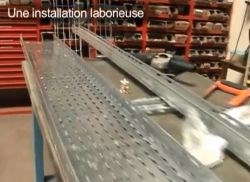
|
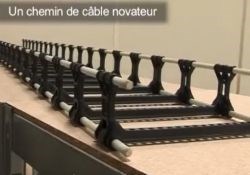
|
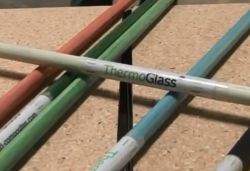
|
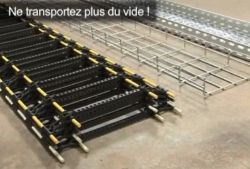
|
CABLEBOX cable tray and ladder system for wiring runs uses pultruded thermoplastic composites. SOURCE: CQFD Composites
CQFD Composites (Villeurbanne, France) was recognized for its development of a thermoplastic cable tray and ladder system called CABLEBOX to replace traditional metal structures used to support electric cables in industrial and commercial environments. The new design is based on CQFD Composites’ proprietary one-step glass fiber thermoplastic pultrusion technology called ThermoGlass.
The materials typically used — galvanized steel, stainless steel and aluminum — require significant energy and involve large amounts of pollutants. They also require multiple steps to install: cutting, edge protection and electrical grounding. Due to its composite construction, CABLEBOX is lightweight and eliminates corrosion as well as the need for grounding. It is also recyclable and CQFD’s patented modular FLAT PACK system enables very efficient shipment vs. traditional formed metal products. The ingenuity of the design can be seen in this video excerpt:
For the complete video go to: http://www.youtube.com/watch?v=-ElLJHghR9U
Related Content
Composite resins price change report
CW’s running summary of resin price change announcements from major material suppliers that serve the composites manufacturing industry.
Read MorePEEK vs. PEKK vs. PAEK and continuous compression molding
Suppliers of thermoplastics and carbon fiber chime in regarding PEEK vs. PEKK, and now PAEK, as well as in-situ consolidation — the supply chain for thermoplastic tape composites continues to evolve.
Read More3D-woven composites find success in aerospace, space
CAMX 2024: Bally Ribbon Mills experts are displaying the company’s various joints, thermal protection system (TPS) technologies and other 3D woven composites for mission-critical applications.
Read MoreBraskem demonstrates PP solutions using Weav3D composite lattice technology
Partnership combines Braskem’s polypropylene sheets with Weav3D Rebar for Plastics technology to address new structural, automotive applications requiring high-strength, lightweight material solutions.
Read MoreRead Next
Developing bonded composite repair for ships, offshore units
Bureau Veritas and industry partners issue guidelines and pave the way for certification via StrengthBond Offshore project.
Read More“Structured air” TPS safeguards composite structures
Powered by an 85% air/15% pure polyimide aerogel, Blueshift’s novel material system protects structures during transient thermal events from -200°C to beyond 2400°C for rockets, battery boxes and more.
Read MorePlant tour: Daher Shap’in TechCenter and composites production plant, Saint-Aignan-de-Grandlieu, France
Co-located R&D and production advance OOA thermosets, thermoplastics, welding, recycling and digital technologies for faster processing and certification of lighter, more sustainable composites.
Read More



















